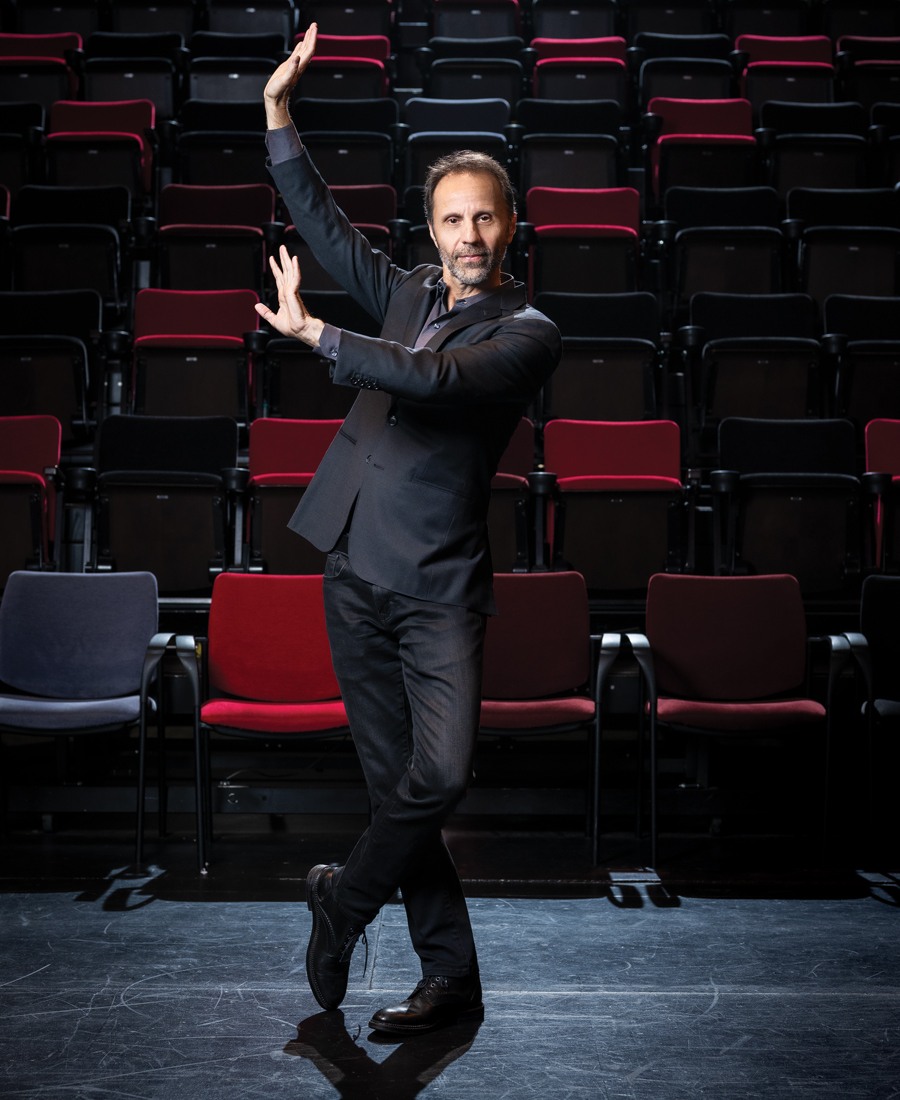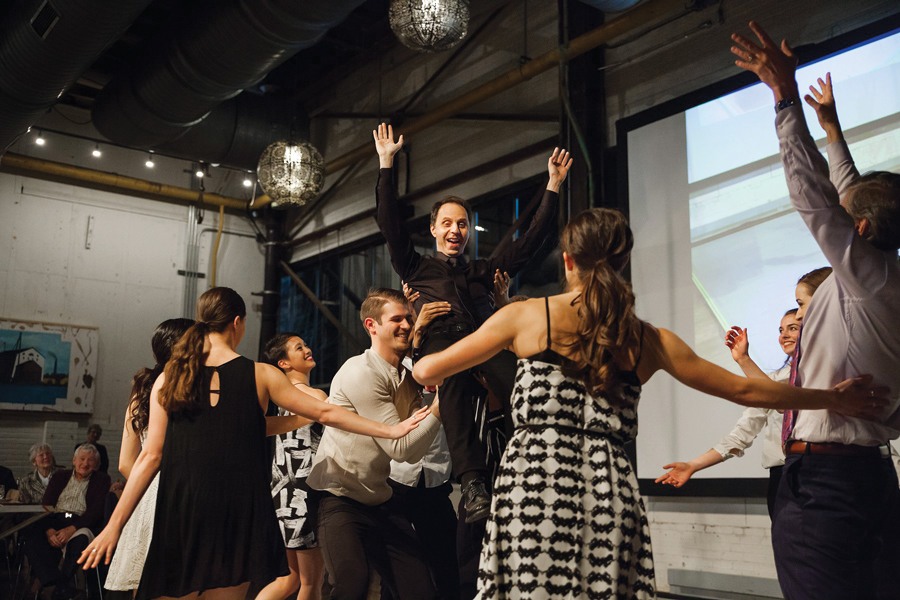Nick Stuccio on the Good, the Bad, and the Very Tense Moments in Philadelphia Fringe Festival History
The festival founder takes a trip down memory lane as he prepares to launch the weird and wonderful event’s 25th season.

Philadelphia Fringe Festival founder Nick Stuccio. Photograph by Linette & Kyle Kielinski
After stumbling into ballet in college — initially to meet ballerinas — Nick Stuccio came to Philly and joined the Pennsylvania Ballet. Then he left the company, starting the Philadelphia Fringe Festival the following year. He talked to us about the surprise hits, his most controversial show, and the scary moment in 2020 when he wondered if it all might evaporate.
Hi, Nick. How has your summer been?
Well, this is the last summer before all three of my kids go away to college for the first time. They’re 18 to 21. So it’s sad, certainly, that they’ll be leaving us. But I am excited for them. I’m remembering how excited I was to go to college. So I’m trying to stay in their perspective.
Are they pursuing the arts?
They don’t know what they’re pursuing. They are amazing arts patrons. They go to everything we do. So my wife and I have turned out three amazing patrons of the arts, and I feel good about that.
I want to get this really important question out of the way up front. I’ve heard you’re connected to Pennsylvania pizza royalty. True or untrue?
True. My grandfather was born in Calabria. And he opened Stuccio’s Pizza 50 years ago or more near Wilkes-Barre. And then my aunt opened her own Stuccio’s Pizza not far from there, and that one is still there. She’s in her 80s. She still makes pizza every day. They make X number of pizzas — and when they’re gone, they’re gone.
Did you come straight to Philly from there?
No. I went to Skidmore College, in Saratoga Springs. I wanted to study science and become a doctor. My first day on campus, I was on my way to play basketball when I walked by the dance studio and stopped and just watched these ballerinas dancing. I was 18. Looking to meet girls. And I watched long enough that the dance teacher came over and said she needed more men in their dance program and asked if I wanted to try it out. I said yes, and I fell in love with it.
Did you graduate with a dance degree?
No. My parents said they would pay for any degree but dance, so I got a degree in biology. But when I graduated, I knew I wanted to try to become a dancer for real. I had family in Philly, so I came down and auditioned for the Pennsylvania Ballet school. I got a scholarship, and then I became a member of the company. And I stuck with them for nine seasons before leaving to start a festival.
Tell me about Philly when you got here.
Oh, God. It was 1986. Philly was a ghost town. A cultural desert. On a Wednesday night at nine o’clock, you could not buy a hamburger. Nobody lived in the city. They all drove their cars into the city, parked them in parking lots, and left. That was it. What a renaissance we’ve had. Ed Rendell was the mayor then, and he has said many times that the Fringe Festival helped make Philly cool. He gives us credit for jump-starting the cosmopolitan reframing of cultural history in Philadelphia, nudging it to where it is today.

Nick Stuccio, center, with BalletX dancers at The Premier Party in 2019. Chris Kendig Photography for BalletX
Your festival, now in its 25th year, was, of course, inspired by the legendary Fringe Festival in Edinburgh. A quarter of a century later, have you achieved what you originally envisioned?
I don’t think I ever really had an ultimate vision for some utopic arts community or some arts-presenting organization. I was just a guy who really liked to put on shows. I wanted to put on shows with artists who are fantastic. That’s where it begins and ends. The vehicle changes and morphs. But the point is to do shows and have beers with the artists afterwards. The rest of it is a means to an end.
Tell me about your first festival, in 1997.
We wanted to present shows. But we didn’t know how. We didn’t know how to sell tickets. We didn’t know how to write a marketing piece that was enticing to the public. We didn’t know how to negotiate contracts. But we learned. And we found places that would give us spaces out of the kindness of their hearts. The third floor of a restaurant. Dungeon basements of bars. We had an artist named Thaddeus Phillips doing Shakespeare with Barbie dolls in an alley, and people were like, “What the fuck is this?” But they loved it.
Did you know going into that first festival that there would be a second, let alone a 25th?
We had no idea if we’d ever do it again. But then, the response not just of the audience but of the artists was very positive. There was such a great feeling in the community, and then people came out asking how they could help, what they could do. And it just took off from there.
“This is our roots. One-on-one. Intimate. Creepy. Weird. If we don’t do that, we lose. We’ll be gone. This has to be a frontier of art and artists. New. Bold. Experimentation that at times results in failure.”
It certainly did. Until it came to a screeching halt in 2020. Was there any point where you thought Fringe might cease to exist?
Yes. We had tripled down on being an in-person business when we bought our Old City headquarters. The business model is to have people stuffed in our restaurant and in the theater. And it was completely empty. There was a bad, sinking feeling. We lost a million in revenue. We lost contributors. But we own the building outright. We don’t have any debt on it, and because we’re a nonprofit, we pay very little tax. So we turned off the AC. We turned off the lights. We unplugged the fridge. We shut it down. We went into our hole and holed up.
What’s a moment of pure bliss from the 25 years you’ve been presenting?
I’ll tell you about one that turned from sheer terror into pure bliss. In 2008, we got a huge grant to bring the conceptual dancemaker Jérôme Bel to the Kimmel Center. His show was a simple idea: 18 pop songs played one after the other and a cast of 18 dancers — some of whom were professional dancers, some who were not — who simply did whatever the song was about. The first song was the Beatles’ “Here Comes the Sun,” and all it was was the song with the audience sitting there for the entire thing, watching a light come up onstage. Then for “Killing Me Softly With His Song,” the dancers all slowly died onstage. For “La Vie En Rose,” the cast walked to the edge of the stage and sat and faced the audience, and a beautiful red light came onto the audience, and the dancers just looked at them. Just sat there. The audience tolerated it, to a point. But then David Bowie’s “Let’s Dance” came on. The cast just stands there. Still. Until David Bowie actually says “Let’s dance,” and then they dance like maniacs.
People didn’t like it?
I heard murmurs. Then seats snapping up. Any presenter knows that seat-snapping noise. And then somebody yelled, “This is bullshit.” This is the Kimmel Center. That never happens at the Kimmel Center. Here I am at the premiere of the show. We got a boatload of money from Pew. I’m thinking the entire audience is going to want their money back, and I’m gonna be sent on a train back to Wilkes-Barre to make pizza.
And yet you’re still here.
I was near tears, but then all of a sudden, the audience began to clap and really get into it. Just like that, the tide turned. People started going nuts. It was just brilliant. And that’s when I realized we could reach out into the world and bring in any artist, and that people would come. But this was 2008, so it took us quite a long time to get to that point.

The art installation Zon-Mai by Sidi Larbi Cherkaoui and Gilles Delmas at the 2011 Fringe Festival. Photograph by Kevin Monko
What has been one of the more controversial presentations?
In 2008, we brought in Rodrigo Garcia, who does work about consumerism. He brought us his famous lobster show. An actor takes a big lobster, cuts it in half, and cooks it, all while there’s a microphone on the lobster’s heart. We listen to it die. That’s the show. I saw it where the audience tried to storm the stage. PETA came after us real hard. We had to have all kinds of security.
What’s the most expensive production ever undertaken by Fringe?
Pew gave us $300,000 on a few occasions to bring in some really substantive and substantial shows. One of the shows starts out as a rehearsal hall that then disappears to reveal a very large lake with an actor sitting on a dock. We flooded a space 90 feet wide by 100 feet long to create a body of water that looked deep. It was a big show.
And what’s the best thing you’ve seen that had virtually no budget? To me, that is what the Fringe is all about.
In 1998, the Philly choreographer Brian Sanders did this show Patio Plastico. We were all seated in a parking lot in Old City with no idea what was about to happen. And then all of a sudden, these 12 dancers come clomping down the street wearing Pepsi bottles for shoes. There’s a slip-and-slide and a backyard sprinkler. The lighting source was flashlights. And it was delightful. It was the hit of the Fringe that year. I think he spent $50 on it. I love that kind of theater.
After being at this for 25 years, do you worry that you can become too much of an institution, so that maybe you lose some of the “fringe”? Or do you feel like you’re still finding beauty in weird places and making magic happen?
I think we still do that. Philly dancer Nichole Canuso dancing for one audience member at a time — there’s no revenue there. We love her. This year, the actress Catharine Slusar is doing a 12-minute Samuel Beckett play for eight people at a time. This is our roots. One-on-one. Intimate. Creepy. Weird. If we don’t do that, we lose. We’ll be gone. This has to be a frontier of art and artists. New. Bold. Experimentation that at times results in failure.
Some people have complained over the years that Fringe has made it difficult for starving artists to get into the festival because of various fees you’ve charged for them to participate. It’s one reason some of those artists created the Free Fringe Philly festival two years ago. How do you respond to those criticisms?
There’s something to that. We’ve now done away with charging fees to independent artists, and we will never do that again. We need to figure out ways to use our platform to help them and spend a good chunk of time and money on that. I don’t know what that means exactly right now. But we need to change the relationship. It used to be fee-for-service. We need to just change that to service.
Will all Fringe presentations this year be in-person, or will there be some virtual?
Fuck virtual. I am so sick of it. All of our presentations will be in-person. Some small number of the independent productions will be virtual. … I know I said fuck virtual, but some artists have actually been making some great breakthroughs in digital media. I’ve seen some do the best work of their careers digitally.
Theater criticism has virtually vanished from major media outlets in Philadelphia. Is that a bad thing?
I think it is. Here’s the thing. I have grown up with theater criticism. I understand that it’s now become about everybody’s opinion, about our cultural voice as a whole rather than a singular opinion. I still love to read the opinion of an expert who has the experience to really offer one. But I realize I’m probably in the minority here. I’m not a social media person.
The Walnut Street Theatre has recently come under attack for the rather glaring lack of diversity in its staff and board. How does Fringe hold up under that lens?
It’s a good question, and we’ve been deeply engaged in that question.
My sense is that, like the Walnut Street Theatre, your board and staff are overwhelmingly white.
We are. We’re working on it. Our aspiration is to be an organization that reflects the racial demographics of our city. We’re in the middle of an independent assessment, a hard look at the organization. The board has been taking a deep look at itself. It’s a serious effort. It’s not going to change overnight.
At this year’s Fringe, you have more than 200 productions. I have a busy schedule. What can I absolutely not miss? I need to know. Three shows.
You need to see Kyle Marshall, an emerging New York City-based choreographer who does really interesting work. We are thrilled to have him. The Elevator Repair Service, who did this infamous and great show called Gatz, which was a seven-hour reading of The Great Gatsby. They’re doing a play based on the transcript of James Baldwin and William Buckley debating race in America in 1965. And then you really need to see Sun & Sea. It’s an incredibly rare piece of art. It’s massive. It’s an opera that takes place on a beach being built in a huge warehouse in Nicetown.
I think I can fit those in.
Well, wait.
See, I knew it.
Pig Iron Theatre Company is doing Love Unpunished, a beautiful homage to 9/11. I mentioned Catharine Slusar, who is doing the Beckett — I think the world of her. And then every single artist in Philadelphia will go see Whit MacLaughlin, who happens to be married to Catharine. Whit normally directs shows for New Paradise Laboratories. But this is a show about him. It’s a one-man show, a monologue. He has had a hell of a time the last couple years. He was mugged and shot. His life has changed. He’s been in crisis. And this is a deeply cathartic moment. You can’t miss it.
Last question, totally unrelated to Fringe. I know you’ve lived in Narberth for years, and my wife says the only suburban town she’ll ever move to is Narberth. Is it really all that?
Yes. Yes, it is. All of the developers are trying to swoop in, but we are doing our best to push them out to keep it the way it is. Keep the character of the houses built in the 1920s, like ours. The park is so nice. The wine and spirits shop has the best wines in the region. The one big problem in Narberth is that the pizza is terrible. I keep telling my kids, “Let’s open up a Stuccio’s pizza franchise!” Alas, they’re not having it.
Published as “Staying Power” in the September 2021 issue of Philadelphia magazine.


